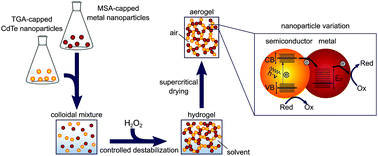Versatile H2O2-driven mixed aerogel synthesis from CdTe and bimetallic noble metal nanoparticles†
Abstract
Mixed aerogels from semiconductor and metal nanoparticles represent an outstanding hybrid material with exceptional properties due to two striking advantages: the creation of a huge quantity of semiconductor–metal interfaces combined with a highly porous three-dimensional nanostructured network. We present a versatile synthetic pathway towards hybrid aerogels built up by joint gelation of CdTe and noble metal nanoparticles (Au, Pd and bimetallic Au/Pd). A straightforward H2O2 treatment inducing gel formation is developed as a more elegant alternative compared to the established photooxidation approach. The use of H2O2 allows a reproducible, simple and mild gel formation which can be easily upscaled. The tremendous influence of the H2O2 concentration on gelation mechanism and gelation kinetics is revealed by photoluminescence quantum yield (PLQY) determinations. Resulting gels are extensively characterized via transmission electron microscopy (TEM), scanning TEM (STEM), energy dispersive X-ray analysis (EDX) as well as photoluminescence (PL) spectroscopy and PL lifetime measurements. By varying the composition of the herein presented noble metal nanoparticles in a controlled fashion the range of semiconductor–metal hybrid aerogels is widened, which demonstrates the versatility and consistency of our approach. This synthetic flexibility grants access to a variety of different mixed hybrid aerogels which are of high significance for catalytic, sensing and photonic applications.



 Please wait while we load your content...
Please wait while we load your content...